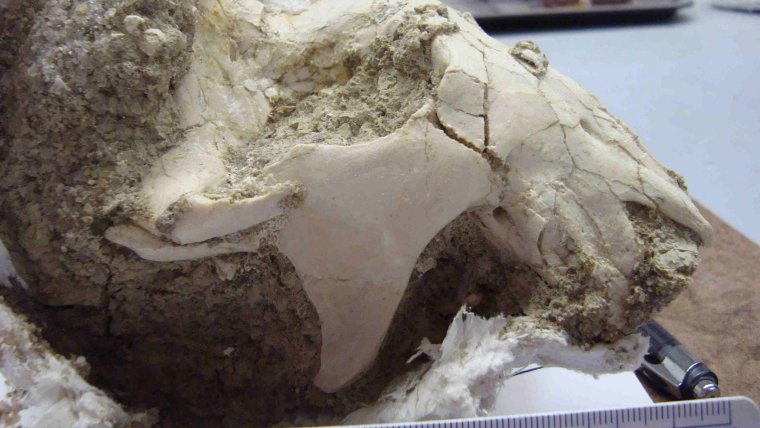| News / Science News |
Scientists discover fossil of bizarre groundhog-like mammal on Madagascar
NSF | NOVEMBER 23, 2014
Paleontologists have discovered an almost complete skull of a previously unknown mammal that likely resembled a large modern-day groundhog and lived alongside dinosaurs.

The skull of the newly discovered mammal Vintana sertichi at an early stage of excavation. ![]()
The species, found on Madagascar, is shaking up theories of early mammal evolution and diversity.
The new fossil mammal is named Vintana sertichi, dating from the Late Cretaceous, approximately 66 million years ago. Vintana means luck and refers to the good fortune its discoverer, researcher Joe Sertich, then of Stony Brook University, had in finding the fossil.
Vintana belongs to a group of early mammals called gondwanatherians, which had been known only from a few teeth and jaw fragments.
Because of this fragmentary understanding, the mammals' evolutionary placement hadn't been clear. The well-preserved skull of Vintana sertichi is giving researchers their first clear insights into the life habits and relationships of gondwanatherians.
The skull measures almost five inches long, twice the size of the largest known mammal skull from the Age of Dinosaurs in the Southern Hemisphere.
At a time when the majority of mammals were shrew- or mouse-sized--mere shadows of dinosaurs--Vintana was a super heavyweight, estimated to have had a body mass of about 20 pounds, two or three times the size of an adult groundhog today.
Vintana's skull has an unusual shape, with deep, huge eye sockets, and long, scimitar-shaped flanges for attachment of massive chewing muscles. Its teeth, eye sockets, braincase, and inner ear revealed that Vintana was likely a large-eyed herbivore that was agile, with keen senses of hearing and smell.
This is the first discovery of a cranial fossil from the extinct group of mammals called Gondwanatheria in the Southern Hemisphere.
YOU MAY ALSO LIKE





